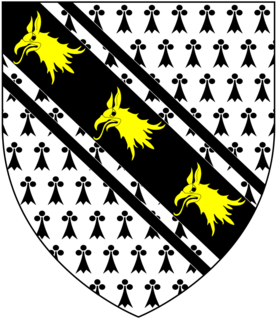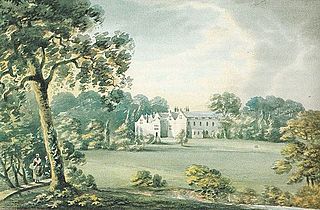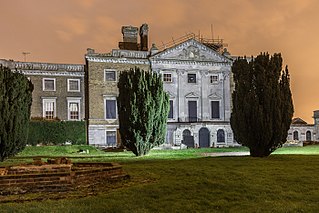
Baron Kilmaine is a title that has been created twice, both times in the Peerage of Ireland. The first creation came in 1722 in favour of the soldier the Hon. James O'Hara. Two years later he succeeded his father as Baron Tyrawley. However, both titles became extinct on the second Baron Tyrawley's death in 1773 without legitimate sons.
Thomas or Tom Palmer may refer to:
Thomas or Tom White may refer to:

Sir Walter Yonge, 2nd Baronet of Great House, Colyton, and of Mohuns Ottery, both in Devon, was a Member of Parliament for Honiton (1659), for Lyme Regis (1660) and for Dartmouth (1667–70).
Events from the year 1622 in England.

The Church of St John the Evangelist is a Scottish Episcopal church in the centre of Edinburgh, Scotland. It is sited at the west end of Princes Street at its junction with Lothian Road, and is protected as a category A listed building.
The Sandford Baronetcy, of Howgill in the County of London, was a title in the Baronetage of England. It was created on 11 August 1641 for Thomas Sandford, subsequently Member of Parliament for Cockermouth. The second Baronet was murdered on 8 September 1675, the same day his son Richard, the third Baronet, was born. The third Baronet later represented Westmorland, Morpeth and Appleby in Parliament. The title became extinct on his death in 1723.

The Davie Baronetcy, of Creedy in the County of Devon, was a title in the Baronetage of England. It was created on 9 September 1641 for John Davie, the Member of Parliament for Tiverton in 1621–22.
The High Sheriff of Roscommon was the British Crown's judicial representative in County Roscommon, Ireland from 1575 until 1922, when the office was abolished in the new Free State and replaced by the office of Roscommon County Sheriff. The sheriff had judicial, electoral, ceremonial and administrative functions and executed High Court Writs. In 1908, an Order in Council made the Lord-Lieutenant the Sovereign's prime representative in a county and reduced the High Sheriff's precedence. However the sheriff retained his responsibilities for the preservation of law and order in the county. The usual procedure for appointing the sheriff from 1660 onwards was that three persons were nominated at the beginning of each year from the county and the Lord Lieutenant then appointed his choice as High Sheriff for the remainder of the year. Often the other nominees were appointed as under-sheriffs. Sometimes a sheriff did not fulfil his entire term through death or other event and another sheriff was then appointed for the remainder of the year. The dates given hereunder are the dates of appointment. All addresses are in County Roscommon unless stated otherwise.
Sir Richard Sandford, 3rd Baronet was an English landowner and Whig politician who sat in the English House of Commons between 1695 and 1707, and in the British House of Commons from 1708 to 1723.
Richard Sandford was a Royal Navy officer.

Sir John Davie, 1st Baronet (1588–1654) of Creedy in the parish of Sandford, near Crediton, Devon, was a member of the Devonshire gentry and served as Member of Parliament for Tiverton in 1621-2 and as Sheriff of Devon (1629–1630). He was created a baronet in 1641.

Sir John Davie, 2nd Baronet (1612–1678) of Creedy in the parish of Sandford, Devon, was Member of Parliament for Tavistock, Devon, in 1661 and was Sheriff of Devon from 1670 to 1671.

Sir John Chichester, 4th Baronet of Youlston Park in the parish of Shirwell near Barnstaple, Devon was a British landowner and Tory politician who sat in the House of Commons from 1734 to 1740.

Little Fulford was an historic estate in the parishes of Shobrooke and Crediton, Devon. It briefly share ownership before 1700 with Great Fulford, in Dunsford, about 9 miles (14 km) to the south-west. The Elizabethan mansion house originally called Fulford House was first built by Sir William Peryam (1534-1604), a judge and Lord Chief Baron of the Exchequer. It acquired the diminutive epithet "Little" in about 1700 to distinguish it from Fulford House, Dunsford and was at some time after 1797 renamed Shobrooke House, to remove all remaining confusion between the two places. Peryam's mansion was demolished in 1815 and a new house erected on a different site away from the River Creedy. This new building was subsequently remodelled in 1850 in an Italianate style. It was destroyed by fire in 1945 and demolished, with only the stable block remaining today. The landscaped park survives, open on the south side to the public by permissive access, and crossed in parts by public rights of way, with ancient large trees and two sets of ornate entrance gates with a long decorative stone multiple-arched bridge over a large ornamental lake. The large pleasure garden survives, usually closed to the public, with walled kitchen garden and stone walls and balustrades of terraces. The park and gardens are Grade II listed in the National Register of Historic Parks and Gardens. The estate was the home successively of the families of Peryam, Tuckfield, Hippisley and lastly the Shelley baronets, in whose possession it remains today.

Creedy is an historic estate in the parish of Sandford, near Crediton in Devon. It is named from its location on the west side of the River Creedy. It was the seat of the Davie family from about 1600 until the late 20th century. The mansion house on the estate has been called at various times New House, Creedy House, and as presently, Creedy Park. It was first built in about 1600, rebuilt in 1846, burnt down in 1915 and rebuilt 1916-21. It is surrounded by a large park, the boundary of which is enclosed by a stone and brick wall several miles long.

Sir Thomas Webster, 1st Baronet, of Copped Hall, Essex, and Battle Abbey, Sussex, was a British landowner and Whig politician who sat in the English and British House of Commons between 1705 and 1727.

Sir William Davie, 4th Baronet (1662–1707) of Creedy in the parish of Sandford, near Crediton in Devon, inherited the Davie baronetcy and the Davie estates from his elder brother Sir John Davie, 3rd Baronet (1660–1692), MP for Saltash 1679–85 and Sheriff of Devon in 1688, who died unmarried at the age of 32.








